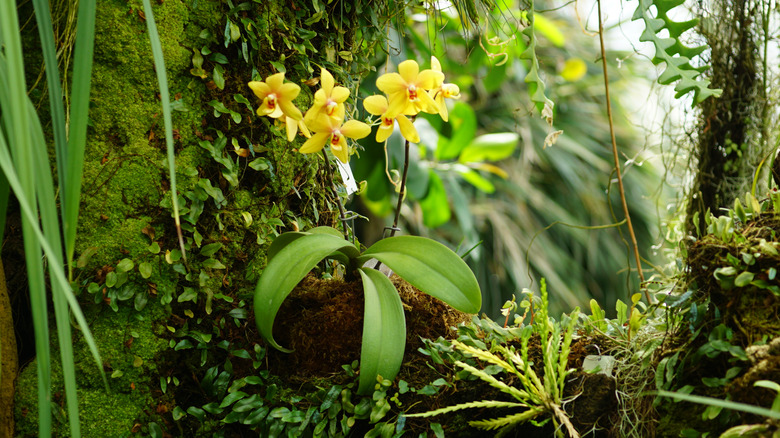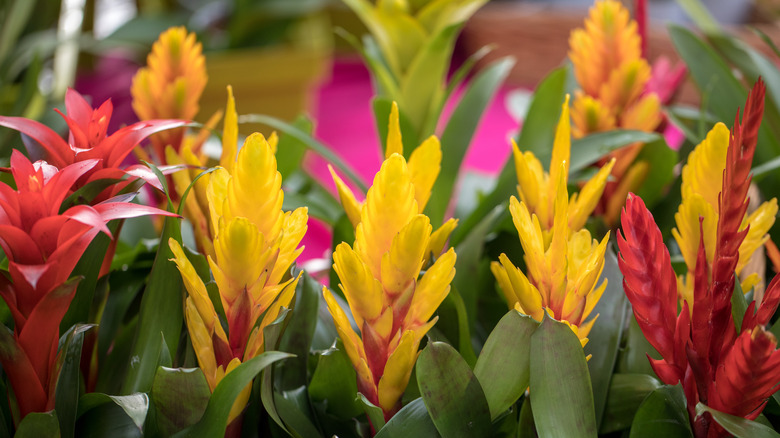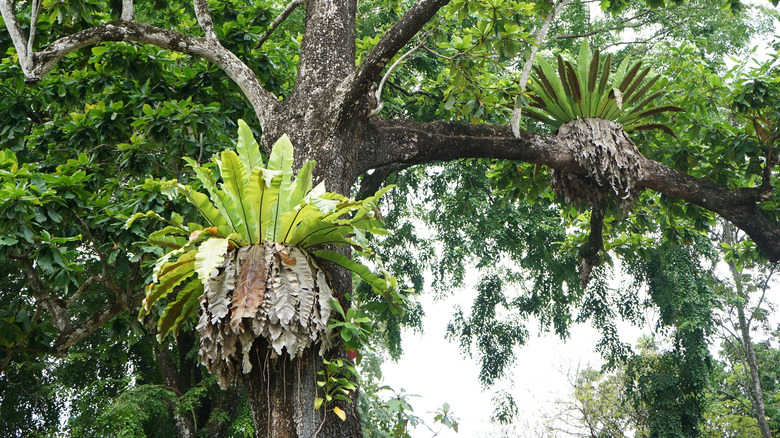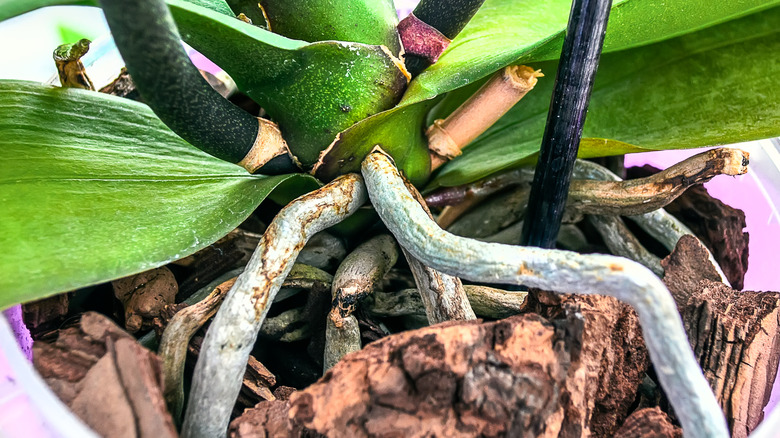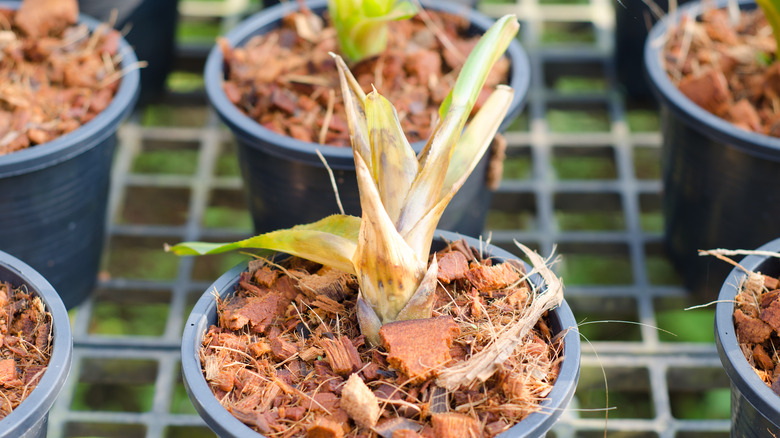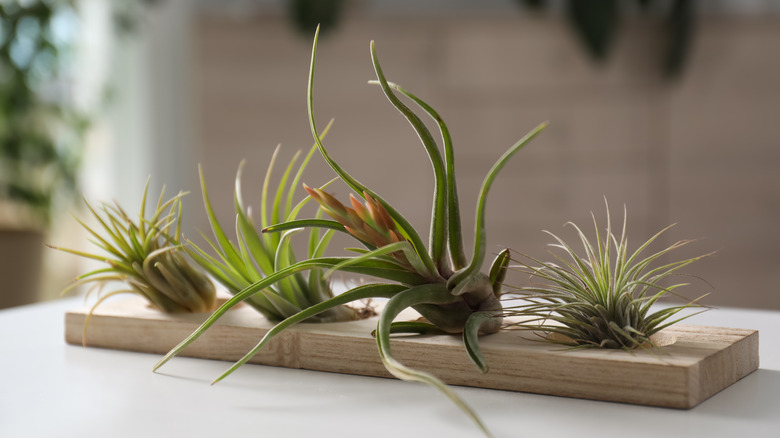What Are Epiphytes And How To Care For Them
To the untrained eye, it may seem like epiphytes are parasites. They rely on a host plant, after all, and isn't that what makes something parasitic? Not exactly, explains Mongabay, a nonprofit news platform dedicated to environmental science and conservation. The key distinction between an epiphyte and a parasite is that the latter (parasite) depletes its host of nutrients while the former (epiphyte) only uses its host as a support structure. Rather than claim the life-sustaining nutrients of others, epiphytes receive everything they need to survive from the air, rainfall, and compost around them. Because of this, they are often found nestled in the crooks of tree branches where organic matter naturally settles and they may even get a small puddle of rainwater to drink from for a few days.
Epiphytic roots can brace themselves into the ground but they don't need to. In fact, the majority of epiphyte species live far up in the rainforest canopies. This is why epiphytes are commonly called air plants. With a name like that, it would seem like air plants could live just about anywhere, including your kitchen or living room. But you have to think twice before bringing these plants indoors. Will you be able to mimic the tropical environmental conditions they're used to?
Different types of epiphytes
Per The New Zealand Epiphyte Network, there are three different categories of epiphytes: holo-epiphytes, climbing vines (called lianas), and hemiepiphytes. The first type lives their entire lifespan from germination to death on a host plant. Holo-epiphytes live in rainforest canopies. blooming brightly and enjoying the plentiful rays of the sun. Orchids are among the most common canopy dwellers, as are bromeliads (pictured above). Between the two, there are tens of thousands of species in an extensive range of colors, shapes, and sizes.
The second type, lianas, can be either herbaceous or woody vines that climb the trees they live on in order to reach up into the canopy. According to Mongabay, there are more than 2,500 species of these climbers. Some of them are unobtrusive thin green vines, while others are much more noticeable. It may be hard to believe but a woody liana can be as thick as a tree and as much as 3,000 feet long!
Hemiepiphytes, the final category, get broken down further into two types. Primary hemiepiphytic plants begin their lives in the canopy and then work their way downward until they establish a connection to the ground. Secondary hemiepiphytes do the opposite. They start life at ground level where it's dark and damp. Then they grow upward, eventually losing that initial contact they had with the earth. Did you know your Monstera Swiss cheese plant is a prime example of a hemiepiphyte?
How epiphytes grow in nature
Epiphytes at ground level situate themselves into crevices and gaps that will offer support while allowing them to conveniently receive sunlight, water, and sustenance. Their knobby roots spread far and wide, adding to the surface area they can cover in order to collect what they need. Decayed leaves, animal droppings, and fallen seeds will all decompose and provide nutrients.
Epiphytes living high in the tree canopies may get more sunlight, but overall they have to work much harder to stay alive. Up there, they're forced to adapt to more complicated environmental conditions, namely a lack of just about everything they need to survive like water and mineral nutrients. To do so, Mongabay explains that they've developed stems and thick leaves that are able to act as tanks and hold water from rainfall. Similarly, some have basket-like enclosures that catch falling debris, which in turn feeds the plant as it breaks down.
Symbiotic relationships regularly form in the rainforest and epiphytes are a part of many of them. While they're busy catching and retaining everything they need, they also end up providing the same sustenance and benefits for other animals and insects. For instance, female poison-arrow frogs climb trees with their tadpoles on their backs until they reach a bromeliad holding a pool of water where they release the tadpoles to swim and grow while feeding on insect larvae.
Indoor container growing requirements for epiphytes
It's true that epiphytes do not need soil, but they can still be potted in containers and grown indoors so long as you're able to mimic their natural environments to some degree. In fact, there are many types of epiphytes that make great houseplants. Life with Plants explains, via their YouTube channel, that the most important factor is creating a suitable potting mix that offers an equal balance of access to air and water. This will allow the roots to breathe and also cut down on fungal issues and root rot.
Coco coir (also called coconut fiber chips), orchid bark, charcoal, and perlite are all porous substrates that create the proper base for epiphytes. Peat moss and organic compost can also be included in small quantities to up the nutrient content. Note that epiphytes will not thrive in a standard garden or potting soil, and whatever you use needs to be very well-draining.
Per Bromeliads.Info, these unique plants can also be mounted on pieces of wood such as driftwood or cork bark. Until they are established, you can keep them tied on with fishing line or wire.
Bright indirect light and humidity are the final components when setting up an appropriate indoor environment. Humidifiers and misters may be necessary. And be sure to avoid long periods of intense direct light since these plants are unaccustomed to such a thing in the dense rainforests of their pasts.
Common pests and diseases with epiphytes
Root and stem rot are the most common problems you're likely to encounter with indoor potted epiphytes. Bromeliads (shown above) and orchids, in particular, are very sensitive to these related problems. Root rot is a serious issue that can claim the life of your plant if you don't act quickly. You might see yellow or dropping leaves, dead roots, and/or shedding flower buds that never get a chance to bloom. If the roots have turned black and mushy by the time you notice that something is wrong, it's probably already too late.
According to Orchid Bliss, the first step in reviving a sick plant is to separate it from its potting mix so the affected roots can dry out. Don't pull on the roots or the base of the plant. Instead, tip the pot over and gently tap it free. Work methodically and delicately so as not to cause further damage. Wipe away any excess soil and then trim the injured roots. Only use clean, disinfected cutting shears to prevent the spread of disease. The remaining healthy roots can be treated with a fungicide. Before repotting your plant in a mix of porous substrates like the ones mentioned earlier, clean and disinfect the container, and let everything dry.
Generally speaking, epiphytes do not suffer from many pest or insect issues.
Popular varieties of epiphytes
We've discussed monsteras, bromeliads, and orchids — all of which are commonly found houseplants that can be grown in containers with appropriate porous potting mixes or as epiphytes with no substrate other than a piece of wood to hang onto. Ferns are also popular indoor plants, some of which are known to improve air quality and humidity inside, potentially making your home healthier.
One more option to consider would be those tiny air plants you often see hanging around eclectic gift shops and nurseries. Like the plants pictured above, these are called Tillandsia and they come in a range of curly leaf patterns and shades of green or other bright colors. Air Plant Supply Co. mounts them on cork bark or arranges them in small glass terrariums. They can hang on their own from hooks you screw into your wall as well.
Air Plant City offers a great tip when caring for Tillandsia in a dry indoor setting. Once every other week, submerge the entire thing in water for a few hours. Spanish moss is in the Tillandsia family and can grow quite large. But don't worry too much — the rest of these plants are usually pretty small!
